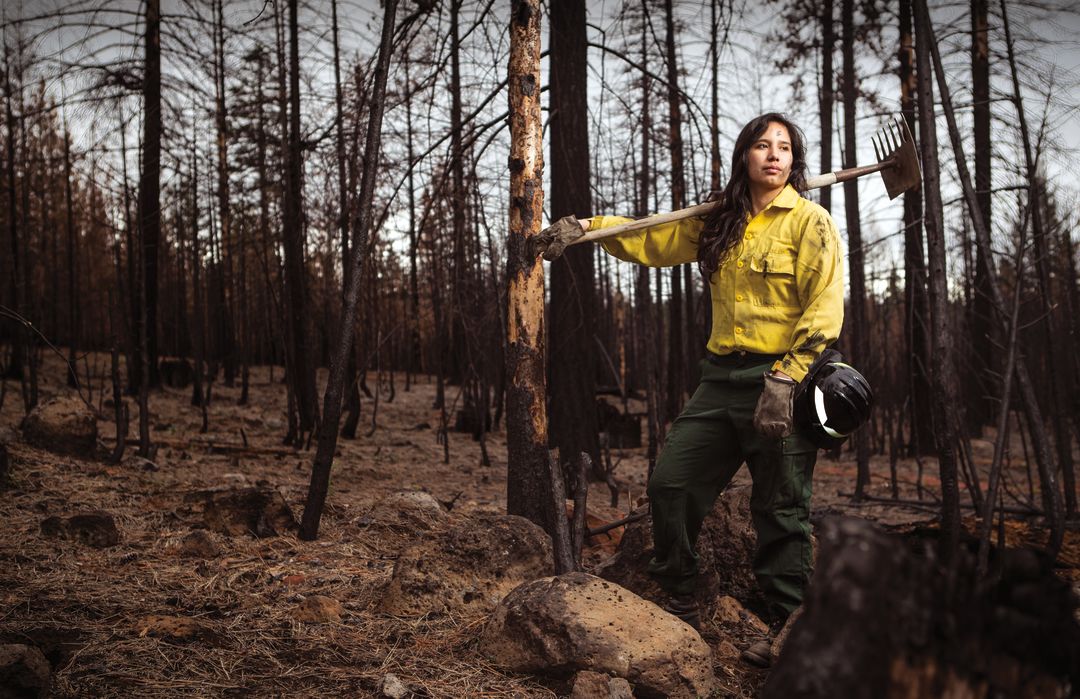For Years, Karlen Yallup Fought Forest Fires Across the West

Firefighter Karlen Yallup at a year-old burn site on the Warm Springs Reservation
Image: Terry Manier
Karlen Yallup grew up in Warms Springs, where smoky late-summer horizons are a fact of life and forestry work employs many on the Confederated Tribes’ reservation. But despite a family of elite fire-suppression “hotshots”—from her mother and older sister to several uncles—Karlen resisted the profession until working in the woods unexpectedly won her heart. Five summers later, she’s battled blazes across the West, while earning dual degrees in forest resources and fire ecology. Next tour? The 24-year-old wants to bring the heat to DC—hopefully with a congressional fellowship, getting up close and personal with the fractious world of federal land management policy.
IT ALL STARTED with my mother; she got on the Warm Springs engine crew. I was 9 when she started going on tours—I didn’t even know what fire was, or forestry. My sister was 18 when she got on a hotshot crew. I always said I’d never get involved in this field, because they were. But then I had this job planned out that I didn’t get [at Kah-Nee-Ta Resort]. The only other offer I got was on a precommercial thinning crew. We cut down junipers all day, for eight hours, and I loved it. Every summer since then, I’ve worked outside.
WE WERE IN Peach Springs, Arizona, on a tour—basically, 14 consecutive days fighting fire. I believe it was day 10, it was hot—Arizona!—and we were all exhausted. I didn’t think anyone knew it was my birthday. My boss told us we were all going to the grocery store to load up on stuff. I was the last out of the store; everyone was in a circle. Someone brought out a cake and they sang happy birthday in their full greens and yellows—like, 30 tired, grumpy guys. Yet they took the time. It was a good day.
THIS PAST SUMMER, I was the only female on my crew. The work is hard. You’re hungry, you don’t shower for two weeks sometimes, you’re miserable. You walk up hills all day with a 50-pound pack on your back. What kept me going was thinking, you’re protecting forests, trees, birds, people, homes.
TRIBES ARE SOVEREIGN. They speak directly to the federal government. So to understand how things work, who does what, I need to better understand government systems and stakeholders. I want to increase the money we get per acre for forestry and fire projects, because right now we get the lowest amount of any land management entity—less than the Forest Service, state and national parks, Fish & Wildlife, everybody. I want it to be equal.
I CAN’T TELL YOU WHERE this was, it’s confidential. We were in what’s called a wildland-urban interface, and the fire front was in waist-deep grass, going towards homes. A helicopter was supposed to drop retardant; that didn’t happen. I got put in charge with a drip torch. Everyone was following me, blacklining around houses. All these trees started scorching—70-foot trees, engulfed in flames. The smoke got thick; no one could see. There were helicopters in the air, and everyone was talking over each other, trying to get on the radio, hearing the fire come. Once the smoke cleared, everything was fine. Just a weird silence. No houses burned, no one got hurt.
I WOULD SAY, LET FIRES BURN. Just protect the houses. Fire is natural—it’s medicine to the land. I don’t believe in suppression, or prescribed fire—where you create atmospheric conditions that don’t allow smoke to disperse into space. Deal with the smoke now, or make my generation deal with it. The ecosystem will naturally make the amount that it needs, and what we need to do is let fires burn.
IT’S NOT JUST FIRE, it’s climate change. It’s invasive species, pests like bark beetles. If things don’t change, Oregon will become a grassland and shrub ecosystem; we’ll lose all our trees. It’s all about balance. And I don’t think, with climate change, that fire management knows what balance is anymore. So nature should do what it wants.




